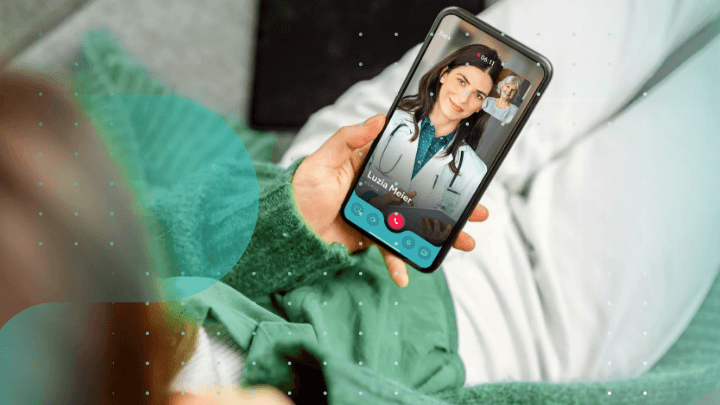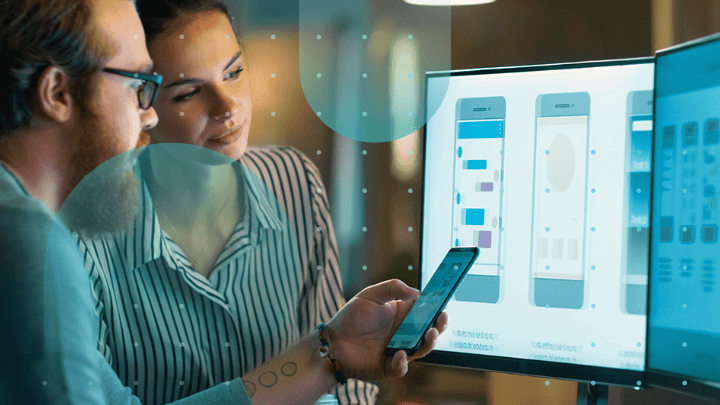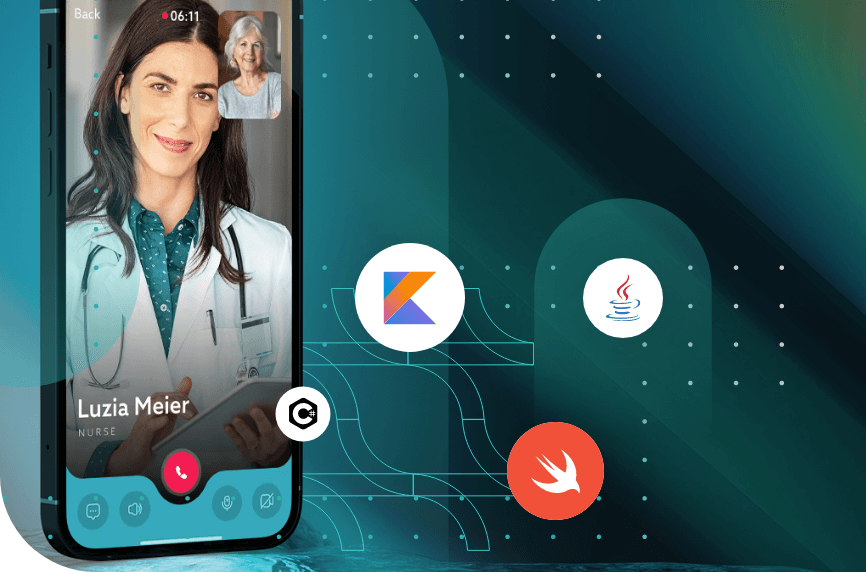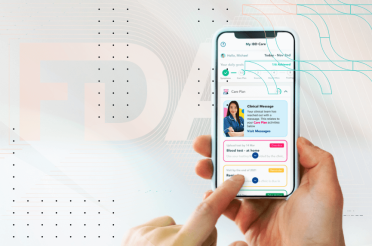The global digital health market hit $45.7 billion in 2020, and it’s not slowing down. Experts predict a compound annual growth rate (CAGR) of 17.6% from 2021 to 2028.
What’s fueling this boom? Government initiatives and cutting-edge innovations in medicine are pushing the healthcare sector into the digital age. One standout example? Virtual nurse apps. These apps are truly changing how patients interact with healthcare providers, making medical assistance more accessible and efficient.
If you’re wondering how to build a virtual nurse app, you’re in the right place. This guide will walk you through everything you need to know, from the latest trends in virtual nurse technology to the step-by-step development process. Let’s dive in!
What is a virtual nurse app?

A virtual nursing app is a healthcare software solution designed to assist patients and healthcare providers through digital means. These apps use artificial intelligence and telemedicine to offer healthcare services like virtual nurse monitoring and remote patient management.
The concept isn’t new. Back in 2013, apps like Sensely introduced virtual nurse avatars that used AI to interact with patients. This marked a turning point in the healthcare industry – it showed how technology could enhance patient care and streamline workflows for healthcare professionals.
Through these platforms, the nursing profession gets a tech boost, as it allows registered nurses to delegate repetitive tasks and focus on more critical aspects of care.
Virtual nurses are not here to replace human nurses but to support them by automating routine tasks and providing patients with 24/7 access to medical assistance.
Why virtual nurse apps are the future of healthcare
The healthcare industry faces numerous challenges, from nursing care shortages to the rising cost of medical services.
Virtual nurse apps address these issues head-on by:
- Reducing nurse burnout: Nurses often juggle multiple responsibilities, from patient care to administrative tasks. Virtual nurse apps, integrated with chatbot integration and nurse online applications, can automate repetitive tasks like data entry, allowing nurses to focus on what they do best—caring for patients. As a result, nursing patients benefit from better care without placing undue pressure on healthcare professionals;
- Improving patient outcomes: With features like remote monitoring and push notifications, these apps help patients manage chronic diseases and adhere to prescribed medication, especially for those with severe medical cases. These features bridge gaps in outpatient services, which is an immense help to healthcare providers who offer continuous care beyond traditional in-person visits;
- Expanding access to care: Virtual nurse apps make healthcare accessible to people in rural areas or those with mobility issues. Patients can consult healthcare providers from the comfort of their homes.
Technologies used for virtual nurse apps
You need to understand the latest development trends in the healthcare industry to build a virtual nurse app that stands out and reaps those benefits. Below are some of the most impactful ones.
Internet of medical things (IoMT) wearable gadgets
The Internet of Medical Things has become a basic necessity in almost every virtual nurse application.
Wearable devices like smartwatches and fitness trackers collect real-time data on a patient’s vitals (heart rate, blood pressure, the person’s physical activity, etc.) which is then transmitted to virtual nurse apps. This data is stored in electronic medical records and analyzed using AI algorithms to provide personalized healthcare recommendations.
For example, a patient with hypertension can use a wearable device to monitor their blood pressure. The virtual nurse app can alert them if their readings are abnormal and suggest lifestyle changes or medication adjustments. That collected information can then be catalogued into medical records and used for smart machine learning algorithms for better diagnosis and treatment plans.
Telemedicine
Virtual nurse apps enable patients to consult healthcare providers via video calls or chatbots. This is especially beneficial for patients with chronic diseases who require regular check-ups but may find it difficult to visit a clinic.
During the COVID-19 pandemic, telemedicine proved its worth by allowing patients to receive medical assistance without risking exposure to the virus.
A clear sign of this is the projected growth of the telemedicine market from 2019 all the way to 2030. Starting at 50 billion USD and expected to grow to a staggering 460 billion USD by the end of the decade. Virtual nurse apps are a key driver of this growth.
Virtual nurse avatar
One thing that virtual nurse apps are said to never be able to replace is the human interactions that a patient can find in the nursing profession. But they are not used to replace people in this case.
Virtual nurse avatars try to mitigate the loss of human connection by providing a friendly, approachable interface for patients. These avatars use natural language processing to interact with users, answering questions and guiding them through self care routines.
Imagine the following. The virtual nurse communicates with a patient and walks them through the steps of managing diabetes, from monitoring blood sugar levels to administering insulin. This not only both improves patient engagement and ensures that healthcare advice is delivered in a clear, understandable way.
Blockchain
Blockchain is usually used to manage financial data and has recently found purchases in the digital healthcare market as well. What it does is gather and write information into interconnected blocks in a way that each block contains data about the previous one.
Its goal is to ensure that a system of data or even a database cannot be simply tampered with or destroyed. Blockchain integration creates an added layer of security, which provides quality assurance engineers with peace of mind when managing sensitive patient data.
It works perfectly with an integrated cloud based system because of the protection it offers to patient data and the inhibition of information leakage. Over recent years, using blockchain technology has come to mean credibility for medical apps because it ensures that time and resources are not wasted.
In addition, HIPAA and GDPR regulatory compliance is guaranteed when using blockchain.
Cloud-based solutions
Virtual nurse apps generate vast amounts of data, from patient records to diagnostic patient reports. Storing this data in a secure database efficiently is a major challenge. Luckily, virtual nurse apps have created similar innovative solutions, which offer a scalable, cost-effective way to manage this information.
Cloud based solutions ease the world of medical providers and practitioners by creating a unified system where information is easily accessed by necessary personnel. It is also strictly protected by blockchain, and this is why integrating the two is a step in the right direction.
How to build a virtual nurse app?

Let us get to the reason you all got here – a neat guide on how to build virtual nurse apps. Mobile app development is not an easy process, especially when it comes to virtual healthcare assistants. Many fields are involved, and a development team has to consist of a variety of experts in most of them.
One such group of people working on the virtual nurse assistant would be an experienced IT development team that will build the application. They would comply with all laws and regulations and make sure the virtual nursing software has its significance and individuality in the precision medicine market.
Something that cannot be overlooked is for the healthcare organization’s in-house technicians to be familiar with all necessary protocols and standards.
There are, of course, a lot of ways this all can be realized. Though it might seem complicated, there are a couple of steps that can be followed to have a smoother and more rapid development process for your virtual nurse assistant app idea.
Step 1: Starting with a strategy
Before you write a single line of code, you need a clear vision for your app. What problem are you solving? Who is your target audience? Will the app cater to patients, healthcare providers, or both? Answering these questions will help you create a roadmap for development.
For example, if your app is aimed at elderly patients, you might prioritize features like voice recognition, large fonts, and simple navigation. On the other hand, if your target users are healthcare professionals, you might focus on integrating electronic medical records and advanced data analytics.
A well-defined strategy also includes understanding the competitive landscape. Research existing virtual nurse assistant apps to identify gaps in the market and opportunities for innovation. This will help you position your app as a unique solution in the developed market of IT healthcare.
Step 2: Necessary requirements
Next, outline the technical and regulatory requirements for your app. This includes understanding data privacy laws like HIPAA and GDPR, as well as user needs such as secure login features and compatibility with wearable gadgets. You’ll also need to estimate the project timeline and budget based on these factors.
For instance, if your app will collect health data like blood pressure and heart rate, you’ll need to ensure it complies with medical data protection standards. This step is crucial for avoiding costly mistakes later in the development process. Make sure you have done your research well, a mistake here, may lead to many hours of wasted work.
Step 3: Analysis and planning
Virtual nursing apps often need to integrate with existing healthcare systems, such as hospital databases or telemedicine platforms. This step involves mapping out how the app will interact with these systems and ensuring a smooth transition.
For example, if your app will handle appointment scheduling, you’ll need to migrate existing appointment data without disrupting current services. This requires close collaboration with healthcare organizations and their IT teams.
Integration planning also includes identifying the data that needs to be migrated to the new system. You can avoid data loss and ensure that the app functions as intended by planning this step carefully
Step 4: Prototypes and design
A good virtual nurse app requires a good user interface (UI). It should be intuitive, visually appealing, navigable and on-brand. A well-designed UI can make the difference between an app that users love and one that frustrates them.
Start by creating wireframes and prototypes that outline the app’s layout and functionality. Work closely with designers to ensure that the app’s design aligns with your brand and meets the needs of your target audience. For example, if your app is aimed at elderly patients, you might use larger fonts, high-contrast colors, and simple navigation menus.
Once the initial design is complete, gather feedback from beta users. This will help you identify any usability issues and refine the design before moving on to development.
Step 5: Writing the code
This is where the magic happens. Developers write the code, integrating features, chatbots, and remote monitoring.
The development phase is divided into several sub-steps, including:
- Front-end development: This involves creating the app’s user interface and ensuring that it works seamlessly across different devices and platforms;
- Back-end development: This includes building the app’s server-side logic, database, and APIs. The backend is responsible for processing data, managing user accounts, and integrating with third-party services;
- AI and machine learning: If your app includes features like virtual nurse avatars or predictive analytics, you’ll need to develop and train machine learning models. This requires a deep understanding of AI algorithms and data science;
- Testing: Throughout the development process, rigorous testing is essential to ensure that the app functions as intended. This includes unit testing, integration testing, and performance testing.
All those phases are assigned to different teams that must work in unison to make sure the app presents a useful and user-friendly experience.
Step 6: User testing
Before launching your app, it’s crucial to test it with real users. User testing helps you identify bugs and ensure that the app delivers a positive user experience.
Start by recruiting a group of beta testers who represent your target audience. Provide them with access to the app and ask them to complete specific tasks, such as scheduling an appointment or monitoring their blood pressure. Gather feedback on the app’s performance and overall experience.
Use this feedback to make any necessary adjustments to the app. This might include fixing bugs or adding new features. User testing is an iterative process, so be prepared to go through multiple rounds of testing and refinement.
Step 7: Release and maintenance
Once your app is ready, it’s time to launch it to the public. But the work doesn’t stop there. Regular updates and maintenance are essential to keep the app running smoothly and address any issues that arise.
After the launch, monitor the app’s performance and gather feedback from users. This will help you identify areas for improvement and plan future updates. You’ll also need to ensure that the app remains compliant with data privacy laws and other regulations.
Maintenance also includes creating backup protocols to ensure the reliability and stability of the app. This is especially important for healthcare apps, where data security and uptime are critical
What are the main reasons for creating a virtual nurse app?

Ok, you know how to create your custom virtual nurse application, but when you begin at the Strategy step, you are going to ask yourself what exactly do I need it for.
As we said, it indeed does address many issues in healthcare, here are the key reasons why it’s a game-changer for patients, providers, and even the industry as a whole.
Mitigating nurse burnouts
Nurses are the backbone of the healthcare system, but they’re often overworked and under immense pressure. Long hours and the emotional toll of patient care can lead to burnout, which negatively impacts both nurses and patients. Virtual nurse apps can alleviate this burden by automating routine tasks like data entry and monitoring patient compliance.
For example, instead of manually entering patient data into electronic medical records, nurses can rely on the app to collect and organize this information. This frees up their time to focus on what they do best—providing compassionate, hands-on care.
Data collection and analysis
Data is the lifeblood of modern healthcare. Accurate, timely data is essential for diagnosing conditions and monitoring patient progress. However, collecting and analyzing this data can be a time-consuming and labor-intensive process for healthcare professionals.
Virtual nursing applications streamline this process by automating data collection and analysis. The app can analyze the data and provide insights to both patients and healthcare providers.
This only saves time and improves the accuracy of diagnoses and treatment plans. For healthcare organizations, it means better decision-making and more efficient use of resources.
Elderly care
The global population is aging, and providing care for elderly patients is becoming increasingly challenging. Many elderly individuals live in rural areas or have limited access to healthcare facilities. Virtual nurse mobile apps offer a solution by enabling remote monitoring and telemedicine services.
For instance, an elderly patient with heart disease can use the app to monitor their vital signs and communicate with their healthcare provider. The app can also send reminders to take medication, attend appointments, and follow a healthy lifestyle.
This not only improves the quality of care for elderly patients but also reduces the burden on caregivers and healthcare systems.
What are the key features every virtual nurse application should have?

So how does the virtual nurse app achieve those benefits – through its many possible features? One must know what virtual nurse app features they want including as early as the planning stage of virtual nurse app development. Let us look at a list of must-have features that every virtual nurse application should include.
Having a profile
Every virtual nurse application has to have a login feature where users have their own accounts. This way, they can access their personal medical information. Patients can keep track of lab results, and other medical notes their doctor has put in, or even for the potential clinical trial participants, they can monitor the trial’s progress.
A vital part of this feature is for there to be an emergency button on the main logic screen that can send out a signal to a healthcare provider in a moment of crisis. This button would be meant to bypass the login screen and get in direct contact with a medical practitioner or emergency service when a patient needs it.
Education
The application can have a whole section dedicated to coaching patients. There could also be medical knowledge laid out, concerning life sciences research, hybrid clinical trials, and other things that concern patients, including even payment management.
All of this information can be given through videos, images, blogs, and articles.
Chatbots
In some cases, patients don’t have a way to visit their healthcare practitioners but still require medical assistance. In such situations, chatbots come in handy. Some patients don’t have the time to go to their healthcare provider or the means of getting there. Chatbots solve this problem by bringing the healthcare provider to them in a way.
Chatbots decrease the cost of transportation and also the time both patients and practitioners spend on a certain problem. Institutions that also suffer from limited human resources can use this function to decrease the load on their nurses and allow them to attend to patients that need their full expertise.
Data collection
The pharmaceutical industry is heavily reliant on information gathering when it comes to drug discovery and drug development. Pharma companies need real-world evidence and data to develop drug exposure models and further improve drug research by upholding pharmaceutical industry trends. Virtual nurse applications can deepen the industry’s role globally in regard to the pharmaceutical market.
The pharma industry also uses big data analytics to lead initiatives in cell and gene therapies and manage rising drug prices. The pharmaceutical sector constantly experiences organic market developments but there always have to be drug pricing measures through health technology assessment.
Appointment scheduling
Managing appointments can be a hassle for both patients and healthcare providers. A virtual nurse app should include a feature that allows users to schedule, reschedule, or cancel appointments with ease.
This feature streamlines the appointment process, reduces no-shows and optimizes healthcare providers’ schedules. It also gives patients more control over their care.
Push notifications and reminders
Putting a patient’s own health management into their own hands has some amazing benefits, but it also bears some risks. Patients can sometimes forget to take their medicine or miss the newly digitally-booked checkups.
The way a virtual nurse application solves this problem is by alerting patients when necessary to engage with the app itself or by visiting a healthcare facility.

Whether you’re a startup, a Fortune 100 company or a government organisation, our team can deliver a solution that works for you.
BGO Software
Conclusion
Creating a virtual nurse application is a great way to step into the growing digital healthcare market. But to know how to develop such an app, one must first consider the current trends of the industry and take into account the features, benefits, and challenges.
Implementing chatbot integration or other fancy new tech in the healthcare domain can streamline physician-patient care. However, the development challenges associated with building a virtual health app are substantial, particularly when integrating advanced features like AI nurses and nursing virtual reality apps.
Experienced developers can overcome these hurdles and deliver truly great results for partner hospitals and organizations. A software partner with years of experience in medical application development can be the game-changer that truly delivers your patients the service they require, while still keeping their medical bills low.
The global health market was valued at $45.7 billion in 2020, and there is an expectation for its compound annual growth rate (CAGR) to be 17.6% from 2021 to 2028.
The key principles for the continuous growth of the market are the support of government initiatives in the healthcare industry and the increasingly complex innovative medicines that are implemented. An example of such initiatives is virtual nurse apps and the digital transformation of the healthcare sector, which are gaining popularity.














